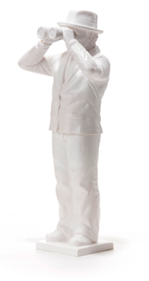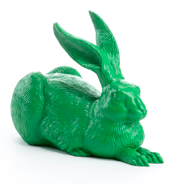
Ihr Warenkorb ist leer.


Ihr Warenkorb ist leer.

The exhibition title "Coexistence" focuses on a particular aspect that is of fundamental relevance to humanity in general as well as to Hörl's artistic approach: the term "coexistence" stands for the simultaneous, peaceful coexistence of different forms of life. In a figurative sense, this means (for Hörl) that different ideas and world views should not be perceived as alien or even threatening. Society and the individual should recognize a potential in diversity. What is not meant by this is that everything must necessarily fit together and make a whole. It would be desirable that a society should have both interest in and respect for the different facets of the individual human being or living being. Thus, on the one hand, it is precisely this respect, and on the other hand, "Hörl's principled questioning of the secret rules of order, of the structural conditions hidden in the diversity of appearances," which, according to art historian Thomas Knubben, run like a thread through his artistic work. This attitude also explains the consequence that Hörl does not submit to any particular style. All genres of art and aesthetic forms of language stand side by side on an equal footing. Accordingly, the exhibition spaces in the museum were curated in a theme-centered manner.
Ottmar Hörl conceived a new serial sculpture especially for the Indang Museum: it is the motif of "Nightingale", the famous nurse, statistician, founder of nursing, reformer of the sanitary system and pioneer of health care. As early as the 19th century, she advocated for medical care for everyone. In the museum context, she is symbolic of the connection between the university's teaching and practice, as well as a tribute to each and every person who dedicates their lives to science and the service of nursing to people, and thus to the common good. The theme is still relevant today. The serial sculpture installation with hundreds of nearly 50 cm high monochrome sculptures is complemented by other installations that open up exciting interactions between the individual works. It is already clear here that the serial, as a fundamental structural element of modern societies, as well as the idea of art as a space for experience and a model of communication that promotes knowledge, are among the essential principles of Ottmar Hörl's work. His concern is to encourage as many people as possible to engage with art.
Recurring leitmotifs, for example, are also the themes of art and nature. Thus the innovative photographic concepts, such as Requiem for Vincent, form the direct link to the painterly portfolio works Il Mare and the serial sculpture of the Matterhorn. The latter literally stands for the realized symbolization of the metaphor "moving mountains". This metaphor can also refer to the creative power of invention as such, as well as to the creative achievements in terms of scientific and revolutionary formulas for space travel, mathematics or chemistry. An entire room is also dedicated to art-historically outstanding positions such as those of Warhol, Duchamp, Beuys and Picasso in the form of serial portraits in various monochrome colors. "The heads have an immediate autobiographical context. They are artists who have accompanied me within my artistic development with their work in an inspiring way," Hörl says.
With this extensive exhibition, the Indang Museum creates a deep, perspective-rich insight into the complex work of Ottmar Hörl, which is now being presented in Asia for the first time in a comprehensive form. The exhibition will be on view until July 20, 2021.
Accompanying the exhibition is a 13-part interview with Ottmar Hörl and Klaus D. Bode, recorded by video.
(Bode Gallery, text: Anna Bode)
Visit the homepage of the Indang-Museum